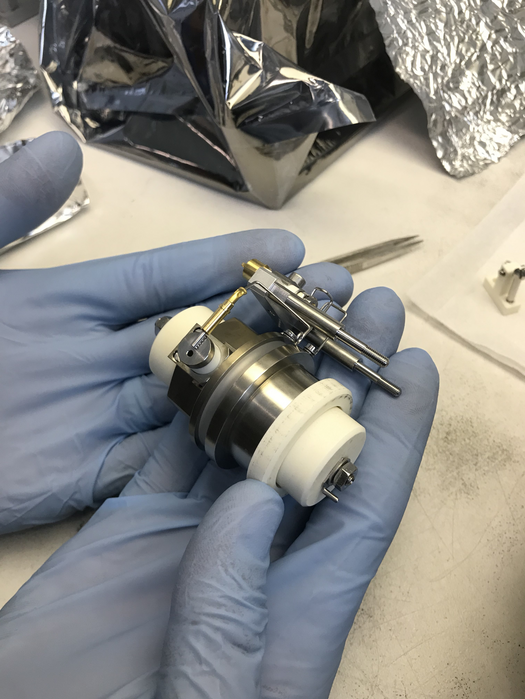As space missions seem to be more challenging into the outer solar system, the requirement for highly compact, resource-conserving, and precise analytical tools have become highly crucial—especially since the search for extraterrestrial life and habitable moons or planets continues.

An Orbitrap cell. Image Credit: Ricardo Arevalo.
A University of Maryland-headed team came up with a new instrument that has been particularly customized to the requirements of NASA space missions. Their mini laser-sourced analyzer seems to be considerably smaller and highly resource efficient compared to its predecessors.
All of this can be done without making any compromise on the quality of its potential to examine planetary material samples and possible biological activity onsite.
The team’s paper on this new device was reported in the Nature Astronomy journal on January 16th, 2023.
The instrument approximately weighs just 17 pounds and is a physically scaled-down combination of two significant tools for detecting signs of life and determining the compositions of materials.
It is a pulsed ultraviolet laser that tends to eliminate small amounts of material from a planetary sample, and an OrbitrapTM analyzer provides high-resolution data regarding the chemistry of the analyzed materials.
The Orbitrap was originally built for commercial use. You can find them in the labs of pharmaceutical, medical and proteomic industries.
Ricardo Arevalo, Study Lead Author and Associate Professor, Geology, University of Maryland
Arevalo added, “The one in my own lab is just under 400 pounds, so they’re quite large, and it took us eight years to make a prototype that could be used efficiently in space—significantly smaller and less resource-intensive, but still capable of cutting-edge science.”
The new gadget of the team contracts down the original Orbitrap while being paired with laser desorption mass spectrometry (LDMS)—methods that have yet to be employed in an extraterrestrial planetary surrounding.
According to Arevalo, the newly-developed device brags similar advantages as its larger predecessors but is efficient for space exploration and onsite planetary material analysis.
The mini Orbitrap LDMS instrument has diminutive mass and the least power needed; as a result, it could be easily stowed away and retained on space mission payloads. Also, the instrument’s examinations of a planetary surface or substance are much less interfering and thus much less probably to ruin or contaminate a sample compared to several present techniques that try to determine unidentified compounds.
The good thing about a laser source is that anything that can be ionized can be analyzed. If we shoot our laser beam at an ice sample, we should be able to characterize the composition of the ice and see biosignatures in it. This tool has such a high mass resolution and accuracy that any molecular or chemical structures in a sample become much more identifiable.
Ricardo Arevalo, Study Lead Author and Associate Professor, Geology, University of Maryland
Furthermore, the mini LDMS Orbitrap’s laser component enables scientists access to bigger and more highly complicated compounds that are more probably to be linked to biology. Smaller organic compounds like amino acids, for instance, are more unclear signatures of life forms.
Amino acids can be produced abiotically, meaning that they’re not necessarily proof of life. Meteorites, many of which are chock full of amino acids, can crash onto a planet's surface and deliver abiotic organics to the surface.
Ricardo Arevalo, Study Lead Author and Associate Professor, Geology, University of Maryland
Arevalo added, “We know now that larger and more complex molecules, like proteins, are more likely to have been created by or associated with living systems. The laser lets us study larger and more complex organics that can reflect higher fidelity biosignatures than smaller, simpler compounds.”
As far as Arevalo and his team are concerned, the mini LDMS Orbitrap will provide much-required awareness and flexibility for future ventures into the outer solar system, as missions focused on life detection objectives (for example, Enceladus Orbilander) and exploration of the lunar surface (for example, the NASA Artemis Program).
The researchers hope to send their device into space and position it on a planetary target of interest in the next few years.
Arevalo stated, “I view this prototype as a pathfinder for other future LDMS and Orbitrap-based instruments. Our mini Orbitrap LDMS instrument has the potential to significantly enhance the way we currently study the geochemistry or astrobiology of a planetary surface.”
The other UMD-affiliated scientists in the research group include geology graduate students Lori Willhite and Ziqin “Grace” Ni, geology postdoctoral associates Anais Bardyn and Soumya Ray, and astronomy visiting associate research engineer Adrian Southard.
This study was financially supported by NASA (Award Nos. 80NSSC19K0610, 80NSSC19K0768, 80GSFC21M0002), NASA Goddard Space Flight Center Internal Research Development (IRAD), and the University of Maryland Faculty Incentive Program.
Journal Reference:
Arevalo, R., et al. (2022) Laser desorption mass spectrometry with an Orbitrap analyzer for in situ astrobiology. Nature Astronomy. doi.org/10.1038/s41550-022-01866-x.